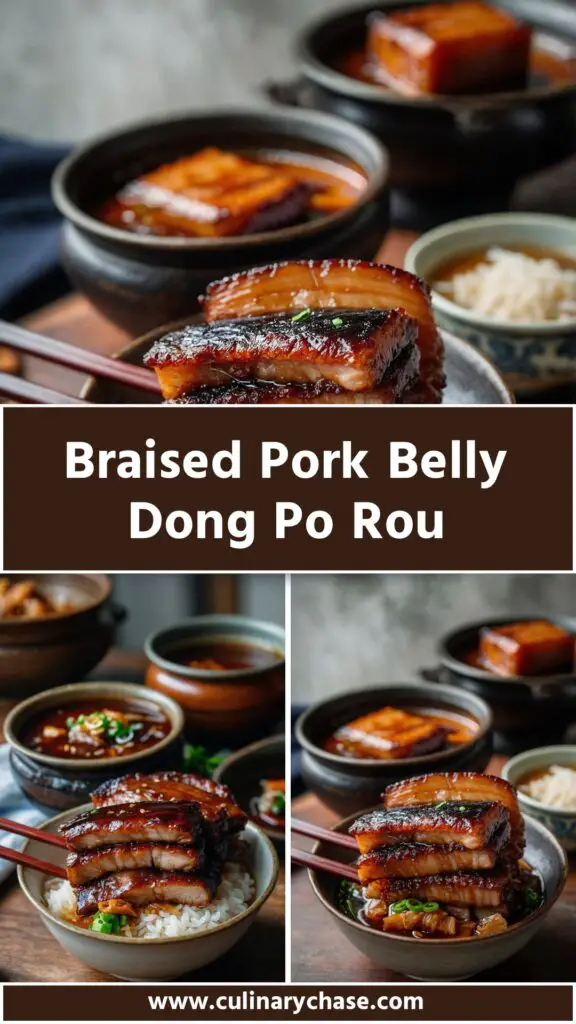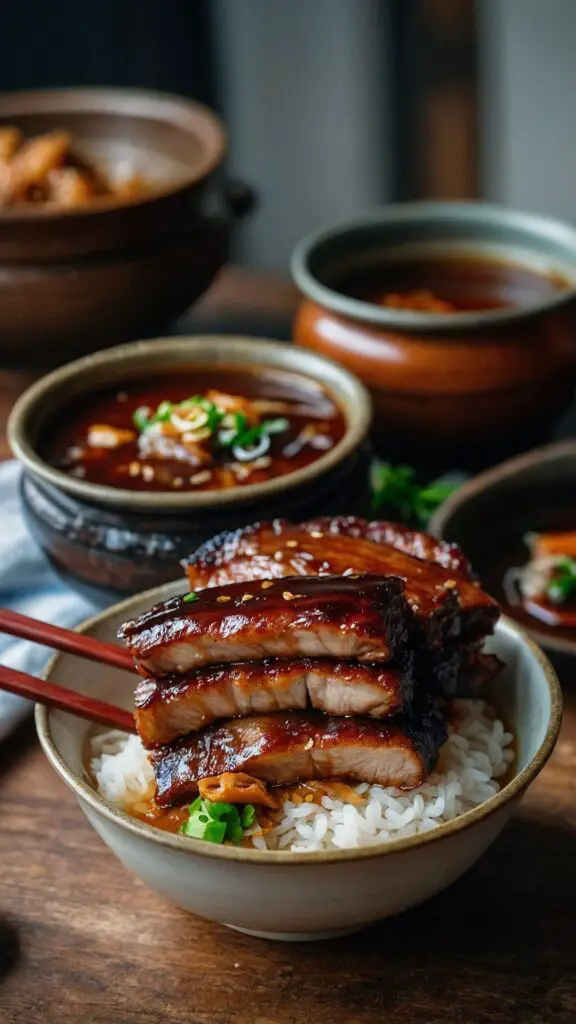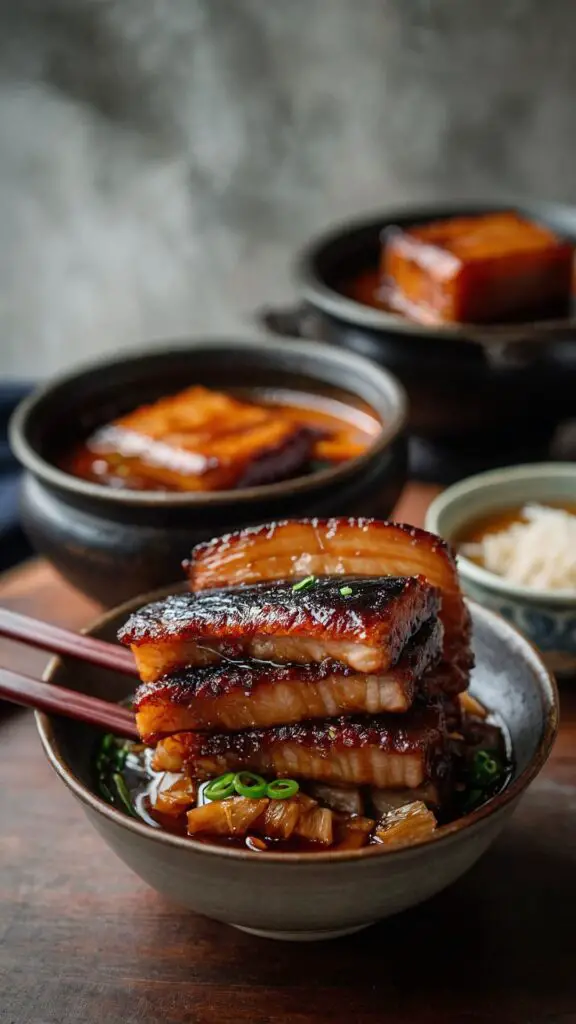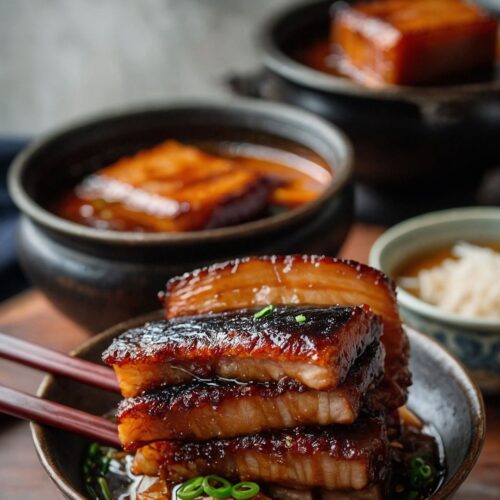Braised Pork Belly Dong Po Rou – Culinary Chase
Before diving into the details of this delectable dish, let’s talk about what you can pair with Braised Pork Belly Dong Po Rou to create a memorable meal. This dish is rich and has a balance of savory, sweet, and umami flavors, making it perfect with a variety of accompaniments.
- Steamed Jasmine Rice: This classic pairing is simple but transforms your plate. The rice soaks up the luscious sauce from the pork belly, allowing you to enjoy every drop.
- Sautéed Greens: Consider garlic sautéed bok choy or Chinese broccoli. The slight bitterness of the greens complements the richness of the pork.
- Pickled Vegetables: A side of pickled cucumbers or radishes adds a refreshing crunch. The tanginess helps cut through the fatty pork belly.
- Soft Boiled Eggs: These can be marinated in soy sauce, giving them a slightly salty flavor that elevates the meal even further.
- Spicy Tofu: Crispy tofu tossed in a spicy sauce brings an additional protein element and contrasts well with the pork’s texture.

Let’s embark on a culinary journey to savor the traditional flavors of Braised Pork Belly Dong Po Rou. This dish isn’t just food; it’s a celebration steeped in history and cultural significance. Originating from the Eastern regions of China, Dong Po Rou is named after the famous poet Su Dongpo. He savored this dish in his time, and today, countless people indulge in its rich history and taste.
Reflecting on my adventures in cooking, I remember the first time I attempted this dish. As I carefully sliced the pork belly and marinated it in a perfect harmony of soy sauce, Shaoxing wine, and spices, I felt an excitement that I now want to share with you. The pleasure of savoring the outcome—rich, satisfying, and aromatic—was a delightful experience!
What is Braised Pork Belly Dong Po Rou?
Braised Pork Belly Dong Po Rou is an iconic Chinese dish. It features tender, melt-in-your-mouth pork belly, simmered to perfection in a treasure trove of flavors. The method of cooking typically involves slow braising, allowing the rich flavors to meld over time. The dish isn’t just about taste; it’s an art that encapsulates centuries-old culinary techniques.
Pork belly is cut into thick slices, often seared before being braised with ingredients like soy sauce, cooking wine, ginger, and aromatic spices, which enhance the savory notes. The rock sugar balances the dish by adding a soft sweetness, cutting through the fattiness of the pork belly. The result is a glossy, dark brown that invites anyone to take a bite.
You will also like the following Side Dishes recipes!
Why You’ll Love This Braised Pork Belly Dong Po Rou
Now, let’s delve into why Dong Po Rou will capture your heart—and your stomach.
- Rich Flavor Profile: The marriage of salty, sweet, and umami flavors creates a complex taste sensation you won’t forget. Each bite unfolds layers of flavors that dance on the palate.
- Texture: The pork belly becomes incredibly tender, contrasting the rich fat with a bit of chewiness. It’s a delightful balance that keeps you coming back for more.
- Cultural Significance: Each serving of Dong Po Rou tells a story. Understanding its historical roots adds a rich depth to your dining experience. Enjoying this dish is like taking a bite out of history.
- Comfort Food: There’s something inherently comforting about slow-cooked meals. Dong Po Rou brings warmth on cold days and is perfect for gatherings with family and friends.
- Versatile: You can pair it with various sides, turning it into a splendid feast. Its ability to shine regardless of the accompaniment is part of its charm.
The Ingredients You Will Need To Make Braised Pork Belly Dong Po Rou
To bring this delightful dish to your table, you’ll need a few essential ingredients. Let’s gather everything you need:
- 2 pounds pork belly slab (the star of the dish)
- 2 ½ tablespoons dark soy sauce (adds depth and color)
- 2/3 cup light soy sauce (for a salty punch)
- 2 cups Shaoxing cooking wine (imparts a complex flavor)
- 4 – 5 oz. rock sugar (adjust for your sweetness preference)
- 3 bunches green onions (washed and halved)
- 8 thin slices fresh ginger (adds warmth)
- 2 star anise pods (for floral notes)
- 1 cinnamon stick (introduces subtle sweetness)

Directions
Let’s get into the fun part—cooking! Follow these steps for success.
Step 1: Prepare the Pork Belly
Start by selecting a good-quality pork belly. Look for meat and fat in balanced proportions. Cut the pork belly into thick slices, about 1.5 inches each. This thickness allows the meat to retain moisture while cooking.
Step 2: Sear the Pork Belly
In a large pot, heat a splash of oil over medium heat. Place the slices of pork belly in the pot, skin-side down. Cook until slightly caramelized and golden brown, around 3-4 minutes. Then flip the slices to sear the other side. Searing adds flavor and color, creating a lovely crust.
Step 3: Add Aromatics
With the pork belly nicely browned, remove it from the pot and set it aside. In the same pot, add ginger, green onions, star anise, and cinnamon. Sauté for a minute until fragrant. This step enhances the aroma of the dish and lays the foundation for the infusion of flavors.
Step 4: Build the Braising Liquids
Pour in your Shaoxing cooking wine, scraping the bottom of the pot to deglaze. Add the dark soy sauce and light soy sauce. Stir in the rock sugar, ensuring it dissolves completely. This combination creates a tantalizing sauce that envelops the pork belly.
Step 5: Braise the Pork Belly
Now, place the previously seared pork belly back into the pot. Ensure the pork is covered in the sauce. Bring the mixture to a gentle simmer, then reduce the heat to low. Cover the pot and allow it to braise for at least two hours. The long cooking time transforms the meat into something incredibly tender.
Step 6: Final Touches
Check on the pork from time to time, adding water if necessary to ensure it doesn’t dry out. Once it’s fork-tender, remove it from the pot. You can strain the sauce if you prefer a smoother texture. For extra shine, consider simmering the sauce until slightly thickened before serving.
Notes
Here are five tips to ensure your Dong Po Rou turns out perfectly:
- Quality of meat: Always opt for high-quality pork belly. Look for a good balance of fat and meat for the best texture and flavor.
- Marinate longer: If you have time, marinate the pork belly overnight for a deeper infusion of flavors.
- Adjust sweetness: Taste the sauce and adjust the sweetness to your liking; some prefer it sweeter, while others may want it less so.
- Use fresh ingredients: Fresh ginger and green onions significantly enhance the overall flavor of your dish. Don’t skimp on freshness.
- Control heat: Keep the braising temperature low and steady. Slow cooking is key to achieving the tender texture you desire.
Storage Tips
Leftovers from this rich dish can last up to three days in the fridge. To store, cover the braised pork belly in an airtight container. You can also freeze the braised pork belly for up to three months. When ready to enjoy again, simply thaw and reheat gently on the stovetop in its sauce to maintain moisture.
Nutrition Information
Here’s a rough overview of the nutritional content per serving (assuming six servings):
- Calories: 450
- Protein: 25g
- Fat: 35g
- Carbohydrates: 15g
- Fiber: 1g
- Sodium: 800mg

Serving Suggestions
When it comes to serving this dish, consider these ideas:
- Over rice: Serve the pork belly over a mound of perfectly steamed rice. The rice will soak in the delectable sauce.
- Garnished with cilantro: Fresh cilantro as a garnish adds a burst of herbal freshness that brightens the dish.
- Alongside a stir-fry: Pair with your favorite vegetable stir-fry for a complete meal.
- Accompanied by soup: It pairs wonderfully with a light soup, creating a well-rounded dining experience.
- In a sandwich: Layer pieces in a soft bao or sandwich for a fusion twist.
What Other Substitutes Can I Use in Braised Pork Belly Dong Po Rou?
If you don’t have pork belly or simply want to switch it up, consider these substitutes:
- Pork shoulder: A great alternative, pork shoulder offers a similar fat-to-meat ratio, although it might take longer to cook.
- Chicken thighs: They will absorb the flavors well and will be quicker to cook, making for a lighter dish.
- Firm tofu: For a vegetarian option, firm tofu can be easily braised in the same sauce. It’s hearty and richly flavorful.
- Duck breast: This will offer a different flavor. The richness of the duck pairs beautifully with the sweet and savory sauce.
- Beef brisket: If you prefer beef, brisket can work although the taste profile will change slightly.

Braised Pork Belly Dong Po Rou
Equipment
- Pot
- Cup
Ingredients
- 2 pounds pork belly slab the star of the dish
- 2 ½ tablespoons dark soy sauce adds depth and color
- 2/3 cup light soy sauce for a salty punch
- 2 cups Shaoxing cooking wine imparts a complex flavor
- 4 – 5 oz. rock sugar adjust for your sweetness preference
- 3 bunches green onions washed and halved
- 8 thin slices fresh ginger adds warmth
- 2 star anise pods for floral notes
- 1 cinnamon stick introduces subtle sweetness
Instructions
Step 1: Prepare the Pork Belly
- Start by selecting a good-quality pork belly. Look for meat and fat in balanced proportions. Cut the pork belly into thick slices, about 1.5 inches each. This thickness allows the meat to retain moisture while cooking.
Step 2: Sear the Pork Belly
- In a large pot, heat a splash of oil over medium heat. Place the slices of pork belly in the pot, skin-side down. Cook until slightly caramelized and golden brown, around 3-4 minutes. Then flip the slices to sear the other side. Searing adds flavor and color, creating a lovely crust.
Step 3: Add Aromatics
- With the pork belly nicely browned, remove it from the pot and set it aside. In the same pot, add ginger, green onions, star anise, and cinnamon. Sauté for a minute until fragrant. This step enhances the aroma of the dish and lays the foundation for the infusion of flavors.
Step 4: Build the Braising Liquids
- Pour in your Shaoxing cooking wine, scraping the bottom of the pot to deglaze. Add the dark soy sauce and light soy sauce. Stir in the rock sugar, ensuring it dissolves completely. This combination creates a tantalizing sauce that envelops the pork belly.
Step 5: Braise the Pork Belly
- Now, place the previously seared pork belly back into the pot. Ensure the pork is covered in the sauce. Bring the mixture to a gentle simmer, then reduce the heat to low. Cover the pot and allow it to braise for at least two hours. The long cooking time transforms the meat into something incredibly tender.
Step 6: Final Touches
- Check on the pork from time to time, adding water if necessary to ensure it doesn’t dry out. Once it’s fork-tender, remove it from the pot. You can strain the sauce if you prefer a smoother texture. For extra shine, consider simmering the sauce until slightly thickened before serving.
Notes
- Quality of meat: Always opt for high-quality pork belly. Look for a good balance of fat and meat for the best texture and flavor.
- Marinate longer: If you have time, marinate the pork belly overnight for a deeper infusion of flavors.
- Adjust sweetness: Taste the sauce and adjust the sweetness to your liking; some prefer it sweeter, while others may want it less so.
- Use fresh ingredients: Fresh ginger and green onions significantly enhance the overall flavor of your dish. Don’t skimp on freshness.
- Control heat: Keep the braising temperature low and steady. Slow cooking is key to achieving the tender texture you desire.
Nutrition
Frequently Asked Questions
Can I make Dong Po Rou in advance?
Absolutely! Dong Po Rou is even better the next day. Make it ahead, refrigerate it, and gently reheat it before serving.
What is the best way to serve Dong Po Rou?
Serve it with rice and garnished with fresh herbs. This provides a good contrast to the rich flavors.
Can I adjust the level of sweetness?
Yes, the amount of rock sugar can be modified based on your preferences. Taste as you go!
How do I make it spicier?
You can add a pinch of chili flakes or some sliced fresh chili while sautéing the aromatics for a kick.
Is there a vegetarian version?
Yes! Using firm tofu or seitan as a base with a similar braising sauce offers a hearty vegetarian option.
Can I use other types of alcohol?
While Shaoxing wine is ideal, any dry white wine can substitute in a pinch but may alter the flavor slightly.
Conclusion
After embarking on this flavorful journey through Braised Pork Belly Dong Po Rou, I hope you feel inspired to try your hand at this dish. It showcases the beauty of traditional Chinese cooking, simple yet devastatingly delicious. Whether you’re serving it at a family gathering or enjoying a cozy dinner at home, this dish never fails to impress.
As you simmer and savor, remember the joy of sharing food with loved ones. Each bite is a moment, a memory just waiting to happen. Happy cooking!
